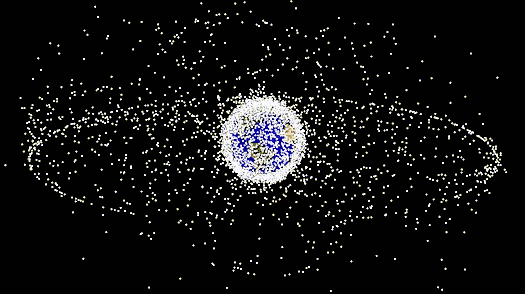by Larry
February, 2009Space Junk HappensOn February 10, 2009, a Russian military satellite and a private U.S. communications satellite traveling over 17,000 miles an hour collided about 500 miles up, creating two very large orbiting debris fields, each of which in turn threatens many other satellites' physical and orbital integrities, not to mention the soft cargo, people who, at some risk and at great expense to the employers, make their living preparing for and then going into space. It turns out there is very little regulation or control over space or space junk. It is not as though we have a traffic cop up there directing who should go in which safe lanes to avoid costly challenges to a basic principle of physics, that two or more bodies may not occupy the same space at the same time. Since the first tiny satellite, Sputnik, was hurled into Earth orbit, in 1957, the orbiting of space junk has become big business. Hundreds of still useful, functioning satellites are aloft at any one time. It might seem it is difficult enough just to assure these do not periodically impact with one another. But they are not the major problem. The number of high velocity space objects 10 cm or more in length whizzing about above us now exceeds 10,000. There are over 50,000 objects at least 1 cm across. The count of still smaller objects in Earth orbit is only a speculation because they are not big enough to be tracked, but is thought to be well in excess of that number.
 A NASA computer image of large Earth orbit objects (illustration in the public domain) Even very miniscule pieces of metal, 1 mm across, for instance, smashing into space-walking astronauts at relative speeds 10-20 times those of the average rifle bullet could ruin their whole day, almost certainly killing them. Space debris is thought to be a culprit in the destruction or early retirement of many satellites. While objects in extremely high orbit, such as the International Space Station (ISS), are thought to be fairly safe from the space junk hazard, nobody knows for sure since the full extent and range of the space junk threat is just not well documented. As collisions, explosions, or other failures have occurred, pieces of early rocket stages have fallen away that were already at orbital velocity, foam and other outer protective materials have come off, etc., the accumulation of space junk has progressed apace. Even as has been true of the polluting of our seas with millions of tons of our plastic and other non-biodegradable trash that threatens marine life into the foreseeable future, we have had a "not my worry" mentality where space junk is concerned as well. Unfortunately, beyond the billions it may cost to replace smashed satellites from time to time, the now vast and growing cloud of space junk, each piece traveling its own trajectory and speed, is complicating the chore of determining safe routes for our missions, whether toward the Moon, Mars, to and from the ISS, and so on. The Hubble Space Telescope has suffered damage from space junk. Our space shuttles have had to have over 80 window replacements due to collisions with space debris. High altitude commercial airlines have had close calls, near misses that almost became space junk impacts. Defunct orbiting pieces of old rocketry, huge satellites, and the like also have a way of coming down from time to time, and as population centers expand they create more vulnerable targets for a final demise of each piece of has-been space detritus. Already an OK woman was hit by a space junk meteorite. Where will it end? It is hardly practical to assign space traffic controllers the duty to keep flying debris x from hitting flying debris y or each of the other scores of thousands of individual pieces whizzing about above us. And there seems currently to be much more incentive to put things up than to remove what is already there. Once things are circling the Earth, inertia assures that it takes some change in the objects themselves or else extra effort or friction to bring them out of orbital velocity, difficult or impossible to achieve for what may be over 100,000 bits of space junk or for anything approaching that number. Perhaps in time there will be huge orbiting robots that swoop this way and that in Earth's surrounding space like great automated vacuum cleaners, clearing paths for the safe ejection of yet more of our jetsam and flotsam. Till that day, it would appear that, just as with our too crowded roadway traffic arteries, overtaxed airline terminals and runways, or our seaports, the choking of space orbits with junk will persist and get much worse before it eventually might get better. |